relevant Publications
Find here relevant scientific publications and technical articles – including from TherVacB project partners. Scroll down to read more about chronic hepatitis B, the virus, screening and testing for hepatitis C and B, therapeutic vaccination, and cure research.
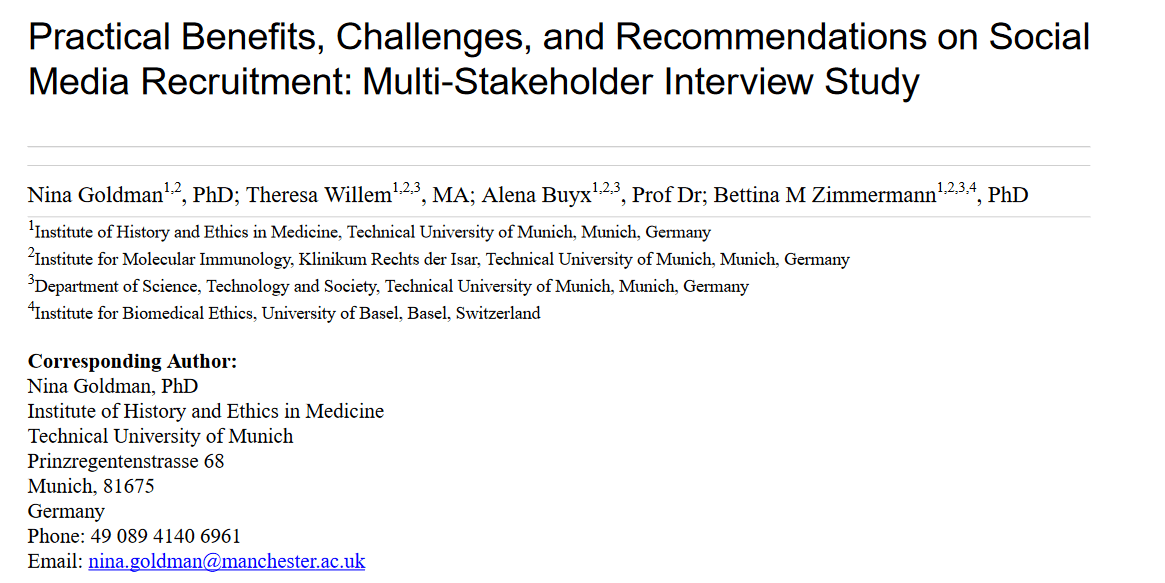
Practical Benefits, Challenges, and Recommendations on Social Media Recruitment: Multi-Stakeholder Interview Study
The increasing use of social media opens new opportunities for recruiting patients for research studies. Based on semi-structured interviews with both people using social media and living with hepatitis B as well as experts in a range of disciplines, authors are exploring the practical benefits of recruiting study participants with social media and are sharing an expert summary on how to conduct social media-based recruitment. Generally, a multiplatform approach with mixed-methods recruitment is the most beneficial recruitment strategy for many research studies. The different recruitment methods complement each other and may contribute to improving the reach of the study, the recruitment accrual, and the representativeness of the sample. Importantly, an assessment of the context- and project-specific appropriateness and usefulness of social media recruitment should be carried out before designing the recruitment strategy.
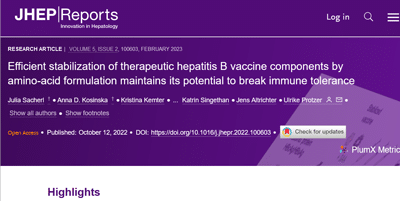
Efficient stabilization of therapeutic hepatitis B vaccine components by amino-acid formulation maintains its potential to break immune tolerance
February 2023 | Journal of Hepatology
Induction of potent, HBV-specific immune responses is crucial to control and finally cure HBV. The therapeutic hepatitis B vaccine TherVacB combines protein priming with a Modified Vaccinia virus Ankara (MVA)-vector boost to break immune tolerance in chronic HBV infection. Particulate protein and vector vaccine components, however, require a constant cooling chain for storage and transport, posing logistic and financial challenges to vaccine applications. Authors of this article aimed to identify an optimal formulation to maintain stability and immunogenicity of the protein and vector components of the vaccine using a systematic approach. This will facilitate global vaccine application without the need for cooling chains and is important for the development of prophylactic as well as therapeutic vaccines supporting vaccination campaigns worldwide.
https://www.jhep-reports.eu/article/S2589-5559(22)00175-6/fulltext
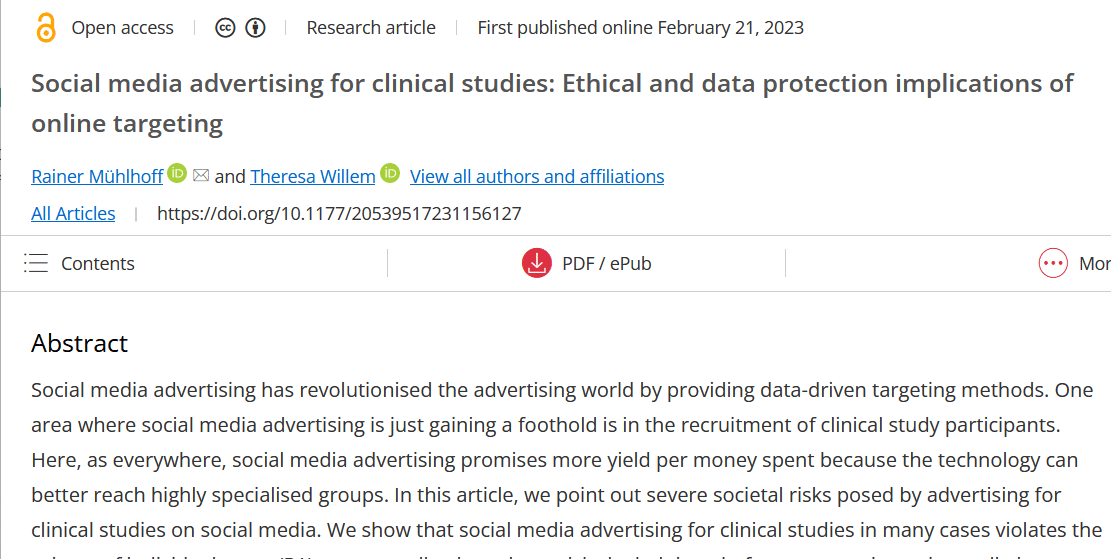
Social media advertising for clinical studies: Ethical and data protection implications of online targeting
21 February 2023 | Big Data & Society
Social media advertising is gaining a foothold in the recruitment of clinical study participants, promising more yield per money spent because the technology can better reach highly specialised groups. In this article, authors point out severe societal risks posed by advertising for clinical studies on social media and call for updates of research ethics guidelines and better regulation of Big Data and inferential analytics. In conclusion, social media advertising – especially with vulnerable patient populations – is deemed unsuitable as a recruitment tool for clinical studies as long as the processing of (even anonymised) social media usage data and the training of predictive models by data analytics and artificial intelligence companies is not sufficiently regulated.
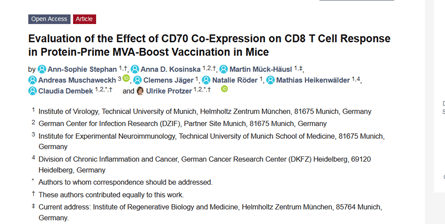
Valutazione dell'effetto della coespressione di CD70 sulla risposta delle cellule T CD8 nella vaccinazione MVA-Prime Protein-Boost nei topi
21 January 2023 | Vaccines – Special Issue Hepatitis Virus Vaccine Immune Therapy
This article investigates the potential of CD70 co-expression during viral vector boost vaccination to improve an antigen-specific T cell response. In sum, the article presents a safe system to selectively enhance the vector-vaccine-induced CD8 T cell response to the target antigen through CD70 co-expression during boost immunization. In this respect, this study may contribute to the development and improvement of therapeutic vaccines revealing novel generic design principles and thus foster advances of current strategies to fight malignancies and persistent viral infections.
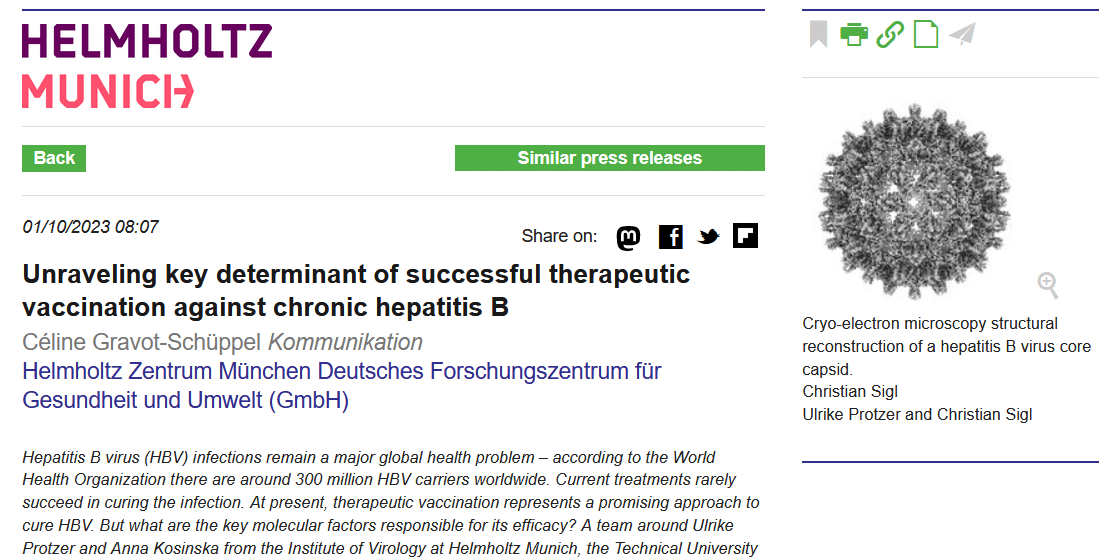
Activation of CD4 T cells during prime immunization determines the success of a therapeutic hepatitis B vaccine in HBV-carrier mouse models
9 January 2023 | Journal of Hepatology
Authors describe the recently developed a heterologous therapeutic vaccination scheme (TherVacB) comprising a particulate protein prime followed by a modified vaccinia-virus Ankara (MVA)-vector boost for the treatment of HBV. However, the key determinants required to overcome HBV-specific immune tolerance remain unclear. In this article, new combination adjuvants and unravel factors are studied that are essential for the antiviral efficacy of the TherVacB vaccination scheme.
Read more about the work by the team around Prof. Dr. Ulrike Protzer and Dr. Anna Kosinska here: https://idw-online.de/en/news807417
https://www.journal-of-hepatology.eu/article/S0168-8278(22)03465-1/fulltext#secsectitle0045
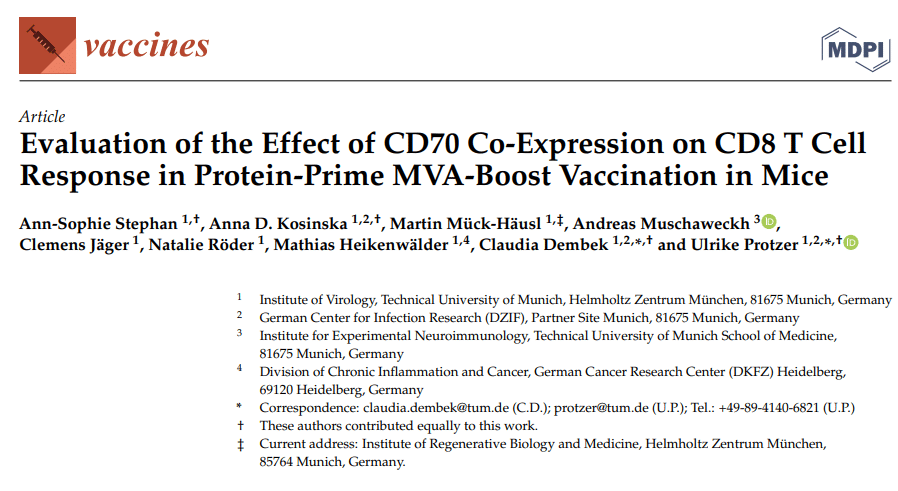
Valutazione dell'effetto della coespressione di CD70 sulla risposta delle cellule T CD8 nella vaccinazione MVA-Prime Protein-Boost nei topi
21 gennaio 2023 | Vaccini – Numero speciale Vaccino contro l’epatite Terapia immunitaria
In questo articolo, il team di ricercatori studia il potenziale della co-espressione di CD70 durante la vaccinazione con vettori virali per migliorare la risposta delle cellule T antigene-specifiche. Nel complesso, questo studio indica che la co-espressione orchestrata di CD70 e di un antigene vaccinale può essere un mezzo interessante e sicuro per potenziare le risposte delle cellule T CD8 antigene-specifiche utilizzando vaccini basati su vettori, anche se nel nostro studio non è stata sufficiente a rompere la tolleranza immunitaria.
https://www.mdpi.com/2076-393X/11/2/245
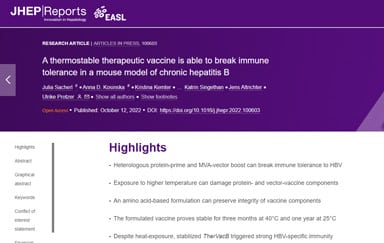
A thermostable therapeutic vaccine is able to break immune tolerance in a mouse model of chronic hepatitis B
12 October 2022 | Journal of Hepatology (JHEP) Reports
Therapeutic vaccination is a promising therapeutic option for chronic hepatitis B that may allow to cure chronic hepatitis B. However, its application requires functional cooling chains during transport and storage that can hardly be guaranteed in many countries with high demand. In this study, the authors including Julia Sacherl, Anna D. Kosinska and Ulrike Protzer, developed thermostable vaccine components that are well tolerated and allow inducing immune responses and control the virus in preclinical mouse models even after long-term exposure to high surrounding temperatures. This will lower costs and ease application of a therapeutic vaccine and thus be beneficial for the many hepatitis B patients worldwide.
Per saperne di più sul lavoro del team del laboratorio del Prof. Protzer: https://www.dzif.de/en/chronic-hepatitis-b-development-thermostable-therapeutic-vaccine.
https://www.jhep-reports.eu/article/S2589-5559(22)00175-6/fulltext
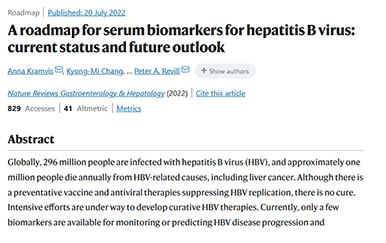
A roadmap for serum biomarkers for hepatitis B virus: current status and future outlook
Globally, 296 million people are infected with hepatitis B virus (HBV), and approximately one million people die annually from HBV-related causes. Although there is a preventative vaccine and antiviral therapies suppressing HBV replication, there is no cure. Intensive efforts are under way to develop curative HBV therapies. Currently, only a few biomarkers are available for monitoring or predicting HBV disease progression and treatment response. As new therapies become available, new biomarkers to monitor viral and host responses are urgently needed. In October 2020, the International Coalition to Eliminate Hepatitis B Virus (ICE-HBV) held a workshop on HBV biomarkers. Various stakeholders from academia, clinical practice, and the pharmaceutical industry, with complementary expertise, presented and participated in panel discussions – including Ulrike Protzer, Mala Maini, and Florian van Bömmel. This Roadmap summarizes the strengths, weaknesses, opportunities, and challenges of HBV biomarkers.
https://www.nature.com/articles/s41575-022-00649-z
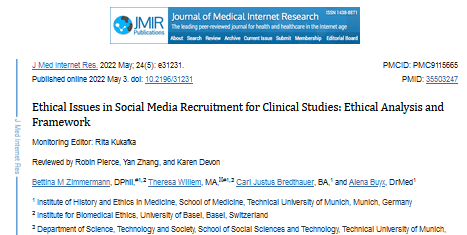
Ethical Issues in Social Media Recruitment for Clinical Studies: Ethical Analysis and Framework
Bettina M Zimmermann, Theresa Willem, Carl Justus Bredthauer, Alena Buyx
Social media recruitment for clinical studies holds the promise of being a cost-effective way of attracting traditionally marginalized populations and promoting patient engagement with researchers and a particular study. However, using social media for recruiting clinical study participants also poses a range of ethical issues. The study summarized in this paper aims to provide a comprehensive overview of the ethical benefits and risks to be considered for social media recruitment in clinical studies and develop practical recommendations on how to implement these considerations.
https://www.ncbi.nlm.nih.gov/pmc/articles/PMC9115665/

Closing in on a cure for hepatitis B
30 March 2022 | Nature
Elie Dolgin
Finite courses of treatment could get the virus under control — with the right combination of drugs.
Read on to know more how TherVacB’s Ulrike Protzer and Mala Maini together with other leading HBV scientists, virologists, viral immunologists and hepatologists around the world have pushed the development of an HBV cure-focused action plan that includes patient perspectives.
https://www.nature.com/articles/d41586-022-00812-1
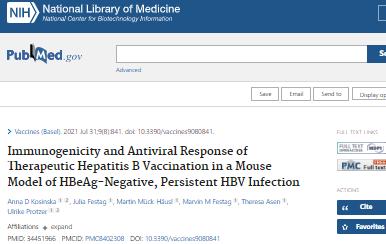
Immunogenicity and Antiviral Response of Therapeutic Hepatitis B Vaccination in a Mouse Model of HBeAg-Negative, Persistent HBV Infection
31 July 2021 | Vaccines
Anna D Kosinska, Julia Festag, Martin Mück-Häusl, Marvin M Festag, Theresa Asen, Ulrike Protzer
During the natural course of chronic hepatitis B virus (HBV) infection, the hepatitis B e antigen (HBeAg) is typically lost, while the direct transmission of HBeAg-negative HBV may result in fulminant hepatitis B. While the induction of HBV-specific immune responses by therapeutic vaccination is a promising, novel treatment option for chronic hepatitis B, it remains unclear whether a loss of HBeAg may influence its efficacy or tolerability. We therefore generated an adeno-associated virus (AAV)-vector that carries a 1.3-fold overlength HBV genome with a typical stop-codon mutation in the pre-core region and initiates the replication of HBeAg(-) HBV in mouse livers. Infection of C57BL/6 mice established persistent HBeAg(-) HBV-replication without any detectable anti-HBV immunity or liver damage. HBV-carrier mice were immunized with TherVacB, a therapeutic hepatitis B vaccine that uses a particulate HBV S and a core protein for prime vaccination, and a modified vaccinia Ankara (MVA) for boost vaccination. The TherVacB immunization of HBeAg(+) and HBeAg(-) HBV carrier mice resulted in the effective induction of HBV-specific antibodies and the loss of HBsAg but only mild liver damage. Intrahepatic, HBV-specific CD8 T cells induced in HBeAg(-) mice expressed more IFNγ but showed similar cytolytic activity. This indicates that the loss of HBeAg improves the performance of therapeutic vaccination by enhancing non-cytolytic effector functions.
https://pubmed.ncbi.nlm.nih.gov/34451966/
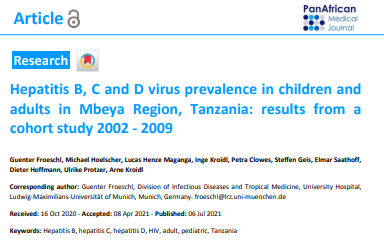
Hepatitis B, C and D virus prevalence in children and adults in Mbeya Region, Tanzania: results from a cohort study 2002 - 2009
6 July 2021 | The Pan African Medical Journal
Guenter Froeschl, Michael Hoelscher, Lucas Henze Maganga, Inge Kroidl, Petra Clowes, Steffen Geis, Elmar Saathoff, Dieter Hoffmann, Ulrike Protzer, Arne Kroidl
Sub-Saharan Africa bears a high prevalence for hepatitis B virus (HBV) infection. This analysis aims at elucidating the exposure to HBV across different age groups in Mbeya Region in Tanzania and determines prevalence of hepatitis C (HCV) and hepatitis delta antigen (HDV) infections.
https://www.panafrican-med-journal.com/content/article/39/174/full/

Screening auf Hepatitis B und C gehört jetzt zur Gesundheitsvorsorge
17 June 2021 | Der Hausarzt.DIGITAL
Ulrike Protzer
Kürzlich wurden Tests auf Hepatitis B und C in die Gesundheitsvorsorge (“Check-up”) aufgenommen. Versicherte ab 35 Jahren können sich einmalig auf diese beiden Erkrankungen untersuchen lassen. Dr. med. Ulrich Scharmer sprach darüber mit der Virologin Prof. Dr. med. Ulrike Protzer, München.
https://www.hausarzt.digital/medizin/praevention/screening-auf-hepatitis-b-und-c-gehoert-jetzt-zur-gesundheitsvorsorge-95051.html
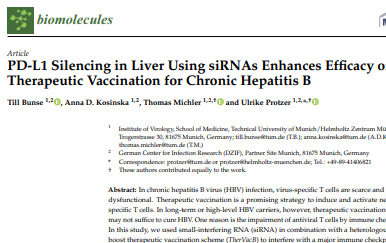
PD-L1 Silencing in Liver Using siRNAs Enhances Efficacy of Therapeutic Vaccination for Chronic Hepatitis B
18 March 2021 | Biomolecules
Till Bunse, Anna D. Kosinska, Thomas Michler and Ulrike Protzer
In chronic hepatitis B virus (HBV) infection, virus-specific T cells are scarce and partially dysfunctional. Therapeutic vaccination is a promising strategy to induce and activate new virus-specific T cells. In long-term or high-level HBV carriers, however, therapeutic vaccination by itself may not suffice to cure HBV. One reason is the impairment of antiviral T cells by immune checkpoints. In this study, we used small-interfering RNA (siRNA) in combination with a heterologous prime-boost therapeutic vaccination scheme (TherVacB) to interfere with a major immune checkpoint, the interaction of programmed death protein-1 (PD-1) and its ligand (PDL-1). In mice persistently replicating HBV after infection with an adeno-associated virus harboring the HBV genome, siRNA targeting PD-L1 resulted in a higher functionality of HBV-specific CD8+ T cells after therapeutic vaccination, and allowed for a more sustained antiviral effect and control of HBV in peripheral blood and in the liver. The antiviral effect was more pronounced if PD-L1 was down-regulated during prime than during boost vaccination. Thus, targeting PD-L1 using siRNA is a promising approach to enhance the efficacy of therapeutic vaccination and finally cure HBV.
https://www.mdpi.com/2218-273X/12/3/470
